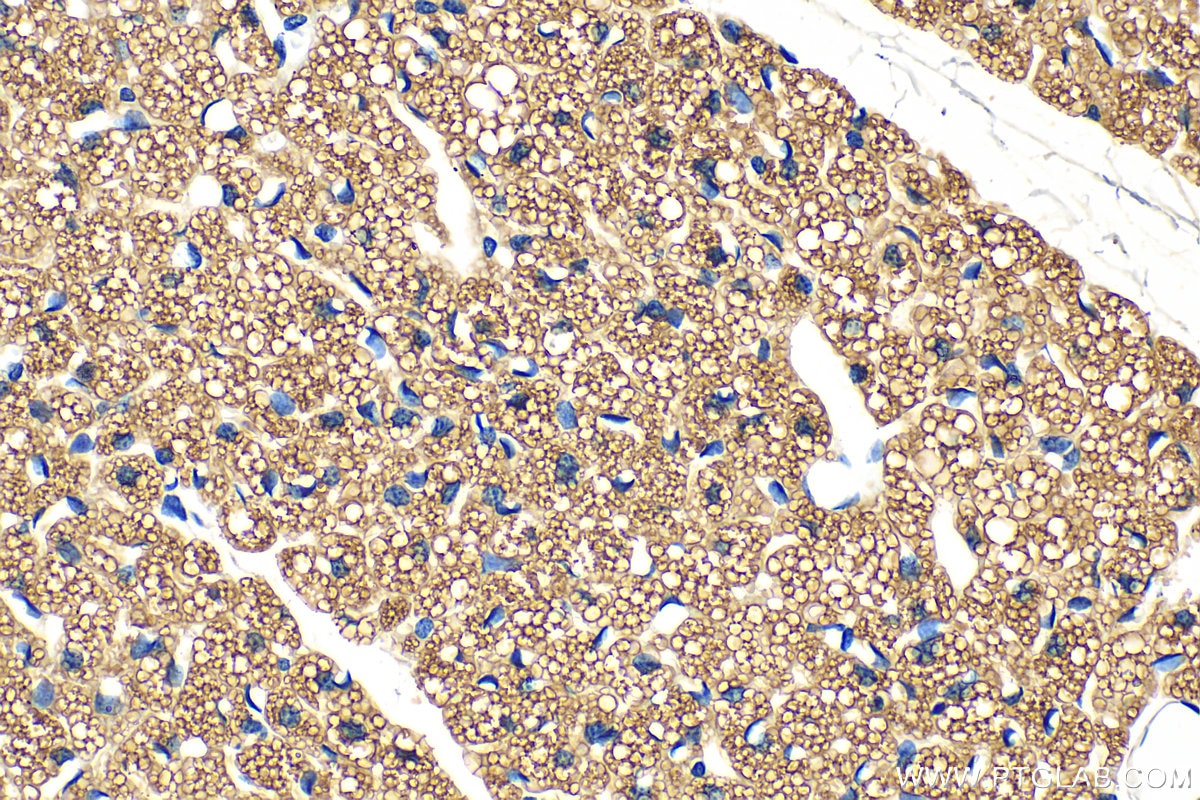Tested Applications
| Positive WB detected in | mouse adipose tissue, pig adipose tissue |
| Positive IHC detected in | mouse brown adipose tissue, mouse testis tissue Note: suggested antigen retrieval with TE buffer pH 9.0; (*) Alternatively, antigen retrieval may be performed with citrate buffer pH 6.0 |
Recommended dilution
| Application | Dilution |
|---|---|
| Western Blot (WB) | WB : 1:1000-1:8000 |
| Immunohistochemistry (IHC) | IHC : 1:200-1:800 |
| It is recommended that this reagent should be titrated in each testing system to obtain optimal results. | |
| Sample-dependent, Check data in validation data gallery. | |
Published Applications
| WB | See 22 publications below |
| IHC | See 2 publications below |
| IF | See 4 publications below |
| IP | See 1 publications below |
Product Information
17333-1-AP targets HSL in WB, IHC, IF, IP, ELISA applications and shows reactivity with human, mouse, pig samples.
| Tested Reactivity | human, mouse, pig |
| Cited Reactivity | human, mouse, rat, pig, bovine |
| Host / Isotype | Rabbit / IgG |
| Class | Polyclonal |
| Type | Antibody |
| Immunogen | HSL fusion protein Ag11360 Predict reactive species |
| Full Name | lipase, hormone-sensitive |
| Calculated Molecular Weight | 117 kDa |
| Observed Molecular Weight | 84 kDa |
| GenBank Accession Number | BC070041 |
| Gene Symbol | HSL |
| Gene ID (NCBI) | 3991 |
| RRID | AB_2878386 |
| Conjugate | Unconjugated |
| Form | Liquid |
| Purification Method | Antigen affinity purification |
| UNIPROT ID | Q05469 |
| Storage Buffer | PBS with 0.02% sodium azide and 50% glycerol , pH 7.3 |
| Storage Conditions | Store at -20°C. Stable for one year after shipment. Aliquoting is unnecessary for -20oC storage. 20ul sizes contain 0.1% BSA. |
Background Information
Hormone sensitive lipase (HSL) belongs to the 'GDXG' lipolytic enzyme family. In adipose tissue and heart, it primarily hydrolyzes stored triglycerides to free fatty acids, while in steroidogenic tissues, it principally converts cholesteryl esters to free cholesterol for steroid hormone production. HSL has two isoforms with the molecular mass of 117 kDa and 84 kDa.
Protocols
| Product Specific Protocols | |
|---|---|
| WB protocol for HSL antibody 17333-1-AP | Download protocol |
| IHC protocol for HSL antibody 17333-1-AP | Download protocol |
| Standard Protocols | |
|---|---|
| Click here to view our Standard Protocols |
Publications
| Species | Application | Title |
|---|---|---|
Ecotoxicol Environ Saf Paternal cadmium exposure affects testosterone synthesis by reducing the testicular cholesterol pool in offspring mice | ||
Int J Biol Sci LAMC1-mediated preadipocytes differentiation promoted peritoneum pre-metastatic niche formation and gastric cancer metastasis. | ||
Biochim Biophys Acta Mol Cell Biol Lipids DECR1 directly activates HSL to promote lipolysis in cervical cancer cells. | ||
Biochim Biophys Acta Mol Cell Biol Lipids PLK1 promotes cholesterol efflux and alleviates atherosclerosis by up-regulating ABCA1 and ABCG1 expression via the AMPK/PPARγ/LXRα pathway | ||
Epigenetics Differential regulatory roles of microRNAs during intramuscular adipogenesis in Chinese Guizhou Congjiang Xiang pigs. | ||
Food Funct Gentisic acid prevents diet-induced obesity in mice by accelerating the thermogenesis of brown adipose tissue. |











